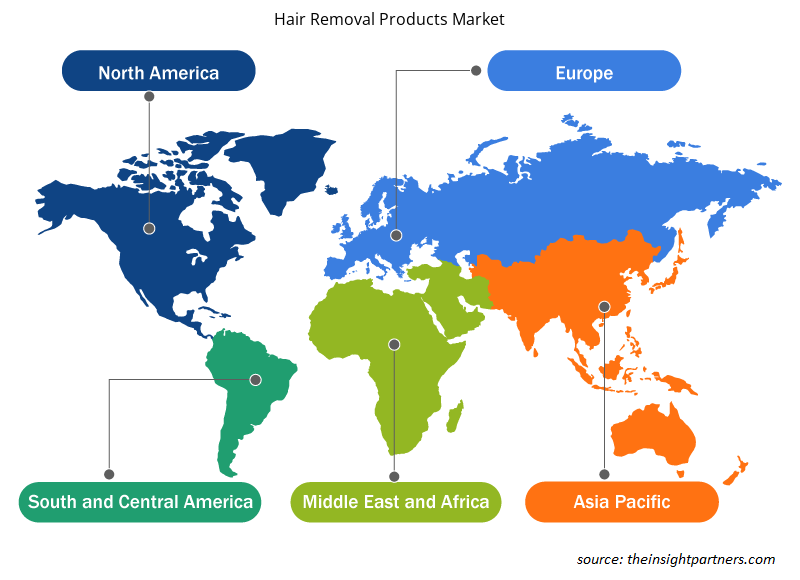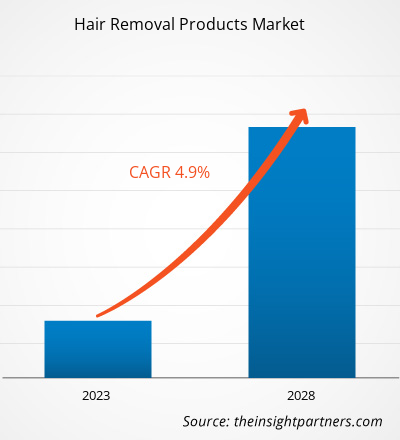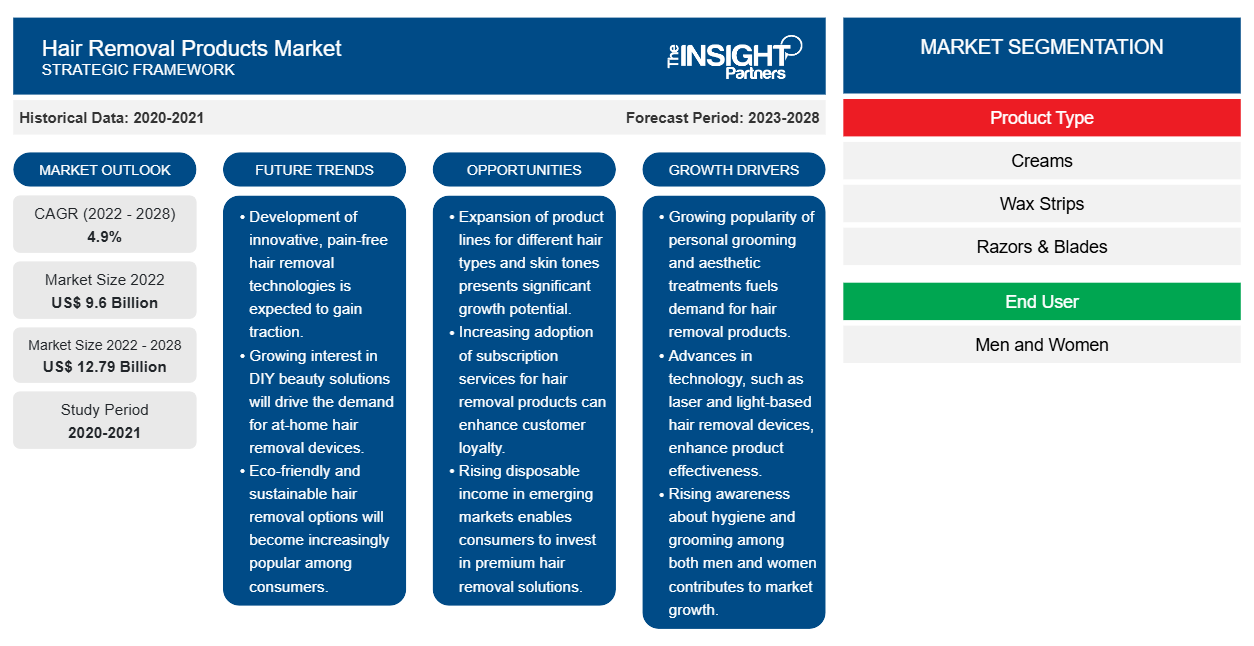[Informe de investigación] Se espera que el tamaño del mercado de productos de depilación crezca de US$ 9.596,39 millones en 2022 a US$ 12.786,19 millones en 2028; se estima que registrará una CAGR del 4,9% de 2022 a 2028.
Los productos depilatorios, como cremas, tiras de cera, maquinillas de afeitar y hojas, depiladoras, cera, aerosoles, geles y otros, se utilizan para eliminar el vello del cuerpo humano. El mercado global está segmentado en función del tipo de producto, el usuario final y el canal de distribución. El aumento de la población y el elevado gasto de los consumidores en productos de cuidado personal, especialmente en los hombres, impulsan la demanda de productos depilatorios en diferentes regiones.
La participación de mercado global de productos depilatorios en Asia Pacífico fue la más grande en 2022. Según el país, el mercado de productos depilatorios en Asia Pacífico está segmentado en Australia, China, India, Japón, Corea del Sur y el resto de Asia Pacífico. Se espera que la influencia de las redes sociales, el aumento de la población y el aumento de la conciencia de las tendencias de moda y estilo impulsen el mercado regional durante el período de pronóstico. Por lo tanto, los principales actores del mercado en la región se centran en desarrollar productos depilatorios innovadores y asequibles para satisfacer los requisitos de los clientes. Además, se espera que la adopción de diversas estrategias de crecimiento, como asociaciones, investigación y desarrollo, campañas de marketing y adquisiciones, impulse el crecimiento del mercado de productos depilatorios en la región en los próximos años. En 2022, Koninklijke Philips NV lanzó la campaña 'Wonder of You' para expandir su segmento de autocuidado de la salud en Asia.
Personalice este informe según sus necesidades
Obtendrá personalización en cualquier informe, sin cargo, incluidas partes de este informe o análisis a nivel de país, paquete de datos de Excel, así como también grandes ofertas y descuentos para empresas emergentes y universidades.
-
Obtenga las principales tendencias clave del mercado de este informe.Esta muestra GRATUITA incluirá análisis de datos, desde tendencias del mercado hasta estimaciones y pronósticos.
Impacto de la pandemia de COVID-19 en el mercado de productos de depilación
Antes de la pandemia de COVID-19, la demanda de productos depilatorios se debía principalmente al elevado gasto de los consumidores en productos de cuidado personal y a la creciente demanda de productos depilatorios para hombres. Sin embargo, varias industrias desaceleraron sus operaciones en 2020 debido a las interrupciones en las cadenas de valor causadas por el cierre de las fronteras nacionales e internacionales en respuesta a la pandemia de COVID-19. La pandemia creó un caos sanitario mundial que interrumpió el funcionamiento de todas las industrias, incluida la industria de bienes de consumo. Las ventas de diferentes productos depilatorios disminuyeron debido al cierre de los salones. Al mismo tiempo, hubo un aumento del tráfico en los sitios de comercio electrónico y más consumidores comenzaron a comprar productos en línea. En 2021, la demanda de productos depilatorios aumentó con la reanudación de las actividades comerciales y el levantamiento de las medidas de confinamiento, lo que se espera que ofrezca oportunidades lucrativas para el mercado de productos depilatorios durante el período de pronóstico.
Perspectivas del mercado
Aumento de la demanda de productos de depilación masculina
El aumento de las campañas de promoción globales sobre productos de depilación personal ha cambiado la perspectiva del cliente desde el estilismo en el salón al cuidado personal en el hogar. Además, la frecuencia de afeitado facial y eliminación del vello corporal no deseado es mayor entre los hombres que entre las mujeres. Los hombres generalmente usan maquinillas de afeitar y hojas para eliminar o recortar el vello facial y prefieren cremas o aerosoles depilatorios para eliminar el vello corporal no deseado. El cambio en la actitud de los hombres hacia los regímenes de cuidado personal o autocuidado ha animado a los fabricantes a desarrollar productos específicos para los tipos de piel y las necesidades de los hombres. Por ejemplo, en 2019, Reckitt Benckiser Group plc lanzó la gama de cremas depilatorias Veet para hombres, que incluye Veet Men Normal y Veet Men Sensitive. Además, varias empresas ofrecen suscripciones a kits de depilación o maquinillas de afeitar a los clientes, en las que la empresa entrega kits de depilación a domicilio en un intervalo regular especificado por el cliente. Por ejemplo, empresas como Harry's, Dollar Shave Club y The Procter & Gamble Company ofrecen cajas de suscripción de depilación. El aumento de la demanda de productos de cuidado personal masculino, como cortadoras de cabello, afeitadoras eléctricas, maquinillas de afeitar , hojas de afeitar y cremas depilatorias, está impulsando el crecimiento del mercado de productos depilatorios.
Información sobre el tipo de producto
Según el tipo de producto, el mercado mundial de productos de depilación se segmenta en cremas, tiras de cera, maquinillas de afeitar y hojas, depiladoras y otros. El segmento de maquinillas de afeitar y hojas tuvo la mayor participación de mercado en 2022. Las maquinillas de afeitar y hojas se utilizan para eliminar el vello de la superficie de la piel. Este proceso no implica el arranque del vello. La depilación con maquinillas de afeitar y hojas es un método conveniente y que ahorra tiempo, y también actúa como exfoliante para eliminar las células muertas de la piel. Las maquinillas de afeitar están disponibles en varios tipos, como maquinillas de afeitar de cartucho, maquinillas de afeitar de seguridad y maquinillas de afeitar eléctricas.
Church & Dwight Co., Inc.; Reckitt Benckiser Group plc; Oriflame Holding AG; GIGI; American International Inc.; Procter & Gamble; Koninklijke Philips NV; Sally Hansen; Si & D (Aust) (Pty) Ltd; y Revitol Corp Players son algunos de los actores que operan en el mercado de productos depilatorios. Estos actores del mercado se centran en proporcionar productos de alta calidad para satisfacer la demanda de los clientes. También están adoptando estrategias como inversiones en actividades de investigación y desarrollo, lanzamientos de nuevos productos, colaboraciones y fusiones y adquisiciones.
Informe Destacado
- Tendencias progresivas de la industria en el mercado de productos de depilación para ayudar a los actores a desarrollar estrategias efectivas a largo plazo
- Estrategias de crecimiento empresarial adoptadas por los mercados desarrollados y en desarrollo
- Análisis cuantitativo del mercado de productos depilatorios de 2020 a 2028
- Estimación de la demanda mundial de productos de depilación
- Análisis de las cinco fuerzas de Porter para ilustrar la eficacia de los compradores y proveedores que operan en la industria
- Avances recientes para comprender el escenario competitivo del mercado
- Tendencias y perspectivas del mercado, así como factores que impulsan y restringen el crecimiento del mercado de productos de depilación
- Asistencia en el proceso de toma de decisiones destacando las estrategias de mercado que sustentan el interés comercial y conducen al crecimiento del mercado.
- Tamaño del mercado de productos de depilación en varios nodos
- Descripción detallada y segmentación del mercado, así como la dinámica de la industria de productos de depilación.
- Tamaño del mercado de productos de depilación en varias regiones con prometedoras oportunidades de crecimiento
Mercado mundial de productos de depilación
Por tipo de producto, el mercado mundial de productos depilatorios se segmenta en cremas, tiras de cera, maquinillas de afeitar y cuchillas, depiladoras y otros. Según el usuario final, el mercado se divide en hombres y mujeres. El mercado mundial de productos depilatorios, según el canal de distribución, se segmenta en supermercados e hipermercados, tiendas de conveniencia, venta minorista en línea y otros.
Perspectivas regionales del mercado de productos de depilación
Los analistas de Insight Partners explicaron en detalle las tendencias y los factores regionales que influyen en el mercado de productos depilatorios durante el período de pronóstico. Esta sección también analiza los segmentos y la geografía del mercado de productos depilatorios en América del Norte, Europa, Asia Pacífico, Oriente Medio y África, y América del Sur y Central.

- Obtenga datos regionales específicos para el mercado de productos de depilación
Alcance del informe de mercado de productos de depilación
| Atributo del informe | Detalles |
|---|---|
| Tamaño del mercado en 2022 | US$ 9.6 mil millones |
| Tamaño del mercado en 2028 | US$ 12,79 mil millones |
| CAGR global (2022-2028) | 4,9% |
| Datos históricos | 2020-2021 |
| Período de pronóstico | 2023-2028 |
| Segmentos cubiertos |
Por tipo de producto
|
| Regiones y países cubiertos |
América del norte
|
| Líderes del mercado y perfiles de empresas clave |
|
Densidad de actores del mercado de productos de depilación: comprensión de su impacto en la dinámica empresarial
El mercado de productos depilatorios está creciendo rápidamente, impulsado por la creciente demanda de los usuarios finales debido a factores como la evolución de las preferencias de los consumidores, los avances tecnológicos y una mayor conciencia de los beneficios del producto. A medida que aumenta la demanda, las empresas amplían sus ofertas, innovan para satisfacer las necesidades de los consumidores y aprovechan las tendencias emergentes, lo que impulsa aún más el crecimiento del mercado.
La densidad de actores del mercado se refiere a la distribución de las empresas o firmas que operan dentro de un mercado o industria en particular. Indica cuántos competidores (actores del mercado) están presentes en un espacio de mercado determinado en relación con su tamaño o valor total de mercado.
Las principales empresas que operan en el mercado de productos de depilación son:
- Compañía Iglesia & Dwight, Inc.
- Grupo Reckitt Benckiser plc
- Oriflame Holding AG
- GIGIO
- Americana Internacional Inc.
Descargo de responsabilidad : Las empresas enumeradas anteriormente no están clasificadas en ningún orden particular.

- Obtenga una descripción general de los principales actores clave del mercado de productos de depilación
Perfiles de empresas
- Compañía Iglesia & Dwight, Inc.
- Grupo Reckitt Benckiser plc
- Oriflame Holding AG
- GIGIO
- Americana Internacional Inc.
- Procter & Gamble
- Philips NV, la línea Koninklijke
- Sally Hansen
- Si & D (Aust) (Pty) Ltd
- Corporación Revitol
- Análisis histórico (2 años), año base, pronóstico (7 años) con CAGR
- Análisis PEST y FODA
- Tamaño del mercado, valor/volumen: global, regional y nacional
- Industria y panorama competitivo
- Conjunto de datos de Excel
Informes recientes
Informes relacionados
Testimonios
Razón para comprar
- Toma de decisiones informada
- Comprensión de la dinámica del mercado
- Análisis competitivo
- Información sobre clientes
- Pronósticos del mercado
- Mitigación de riesgos
- Planificación estratégica
- Justificación de la inversión
- Identificación de mercados emergentes
- Mejora de las estrategias de marketing
- Impulso de la eficiencia operativa
- Alineación con las tendencias regulatorias























 Obtenga una muestra gratuita para - Mercado de productos de depilación
Obtenga una muestra gratuita para - Mercado de productos de depilación